Key takeaways:
- Understanding gender equality requires challenging societal norms and recognizing intersectionality to create inclusive advocacy.
- Gender-sensitive programs are essential for addressing specific needs, boosting confidence, and dismantling stereotypes for all genders.
- Effective community engagement involves active listening, tailoring communication, and co-creating programs to ensure ownership and relevance.
- Monitoring and evaluation, including participant feedback, are crucial for continuous improvement and demonstrating the program’s impact.
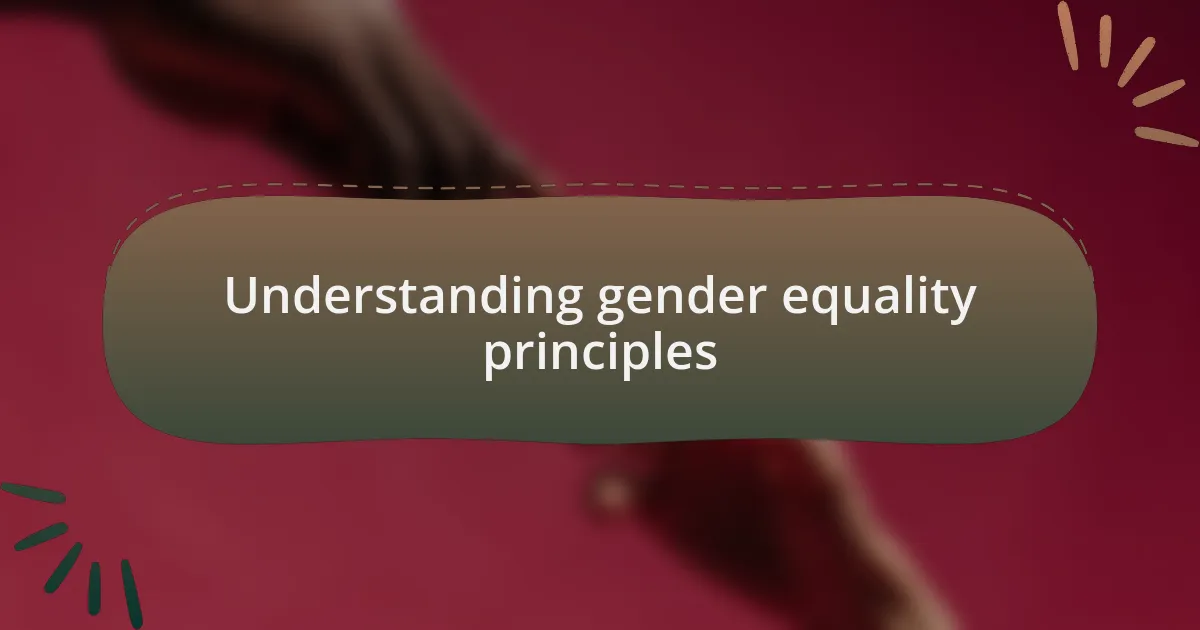
Understanding gender equality principles
Understanding gender equality principles goes beyond just recognizing the differences between genders; it involves actively challenging societal norms that perpetuate inequality. I remember a crucial workshop I attended that opened my eyes to the subtle biases we often overlook. Have you ever considered how language influences our perception of gender? Our words can either reinforce stereotypes or pave the way for change.
A key principle of gender equality is the idea that everyone, regardless of gender, should have equal opportunities and rights. I once met a passionate advocate who shared her journey of empowering women in her community to access education and job opportunities. Hearing her story made me realize how empowering individuals can create a ripple effect, fostering an environment where everyone thrives together.
Moreover, understanding gender equality means acknowledging intersectionality—the interconnected nature of social categorizations like race, class, and gender. This insight hit home when I reflected on how my own privileges shielded me from the challenges faced by others. Have you taken a moment to reflect on how your identity shapes your experiences? This awareness is crucial for fostering a more inclusive approach to advocacy.
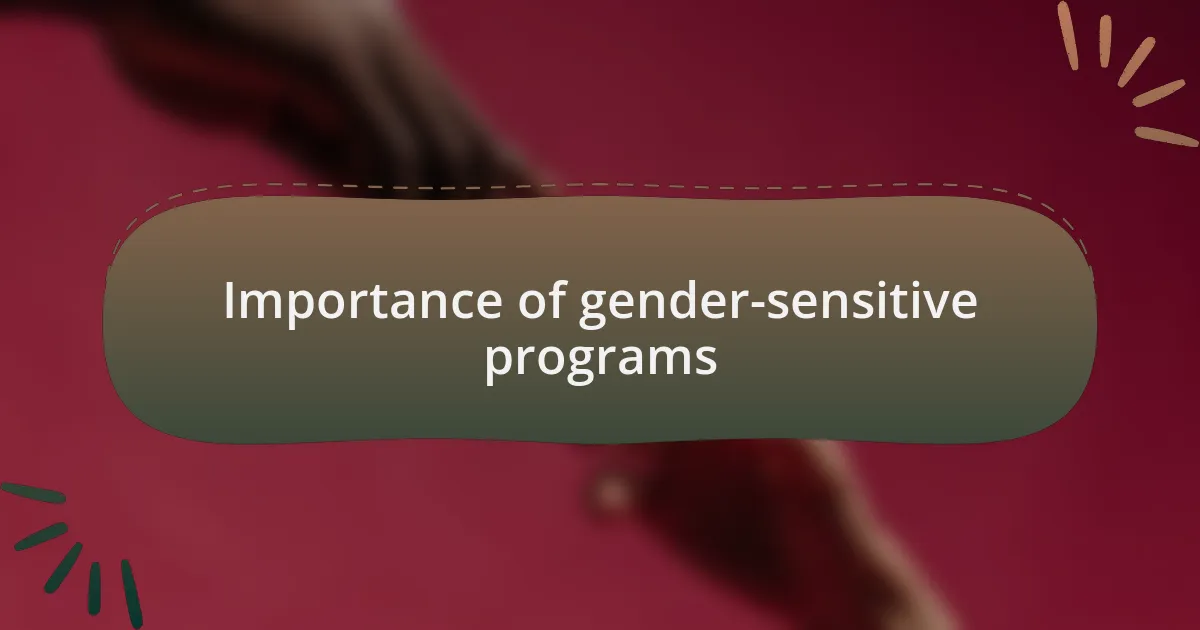
Importance of gender-sensitive programs
Programs that are gender-sensitive play a pivotal role in addressing the unique needs and challenges faced by different genders. I distinctly remember working on a project where we implemented a mentorship program tailored for young girls in STEM fields. The positive impact was profound; not only did it boost their confidence, but it also encouraged them to pursue careers they previously thought were out of reach. How powerful is it to see someone break through barriers simply because they felt supported?
Furthermore, gender-sensitive programs help dismantle the stereotypes that often limit potential. I once attended a panel discussion where male participants shared their experiences of vulnerability and emotional awareness. This was a powerful reminder that gender sensitivity also benefits men, enabling them to express their emotions freely without the fear of being judged. Isn’t it essential for all of us to embrace our humanity, regardless of gender?
Finally, by fostering a culture of inclusivity through these programs, we create environments where dialogue can flourish. I recall a community meeting that focused on understanding male and female perspectives. The mutual respect and understanding that developed were astonishing, as barriers came down through shared stories. Have you taken the time to explore how these conversations can lead to collective empowerment? Each voice matters, and gender-sensitive programs amplify that truth in meaningful ways.
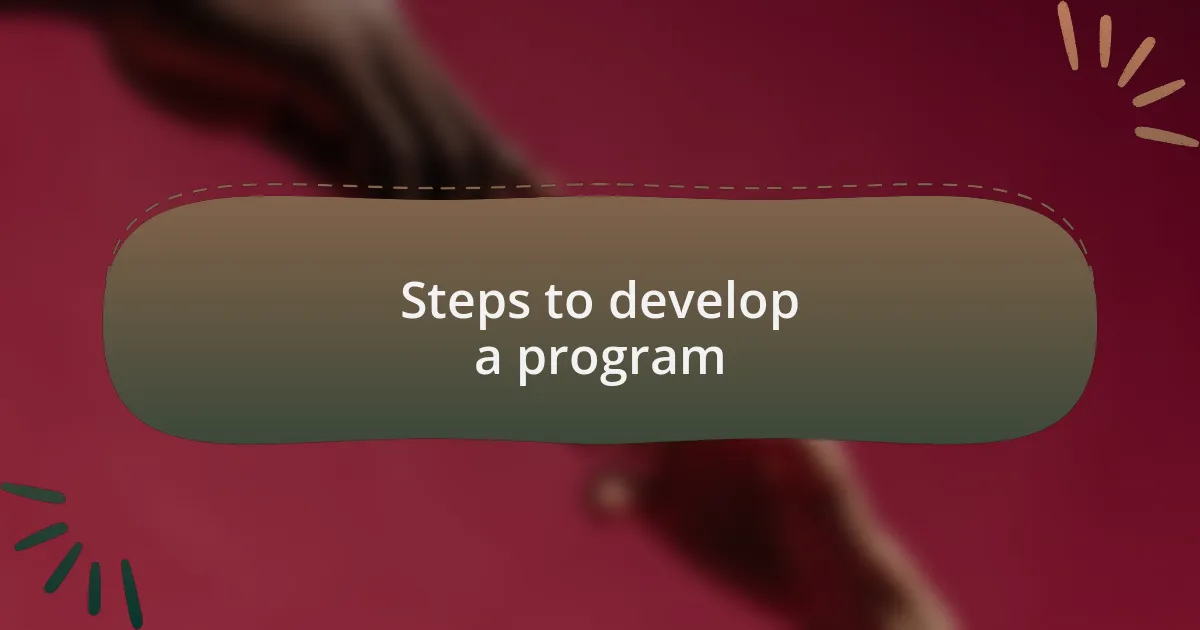
Steps to develop a program
Creating a gender-sensitive program begins with thorough research and consultation. I remember conducting interviews and focus groups with individuals from diverse backgrounds to understand their unique experiences and needs. This step is crucial; it not only informs the program’s objectives but also builds trust within the community. When was the last time you listened to someone’s story and saw the world through their eyes?
Next, it’s vital to set clear goals and measurable outcomes. One time, I worked with a team to develop objectives for a workshop series aimed at promoting gender equality in schools. By defining what success looked like—such as increased awareness or participation rates—we could track progress and adapt the program as necessary. Have you ever considered how setting specific benchmarks can lead to better program execution?
Finally, ongoing evaluation and feedback mechanisms are essential for refining the program. In one instance, we launched a pilot project and actively sought feedback from participants. Adjusting based on their input not only improved the program but also empowered them to take ownership of their learning experience. Isn’t it fascinating how listening can transform a program from merely functional to truly impactful?
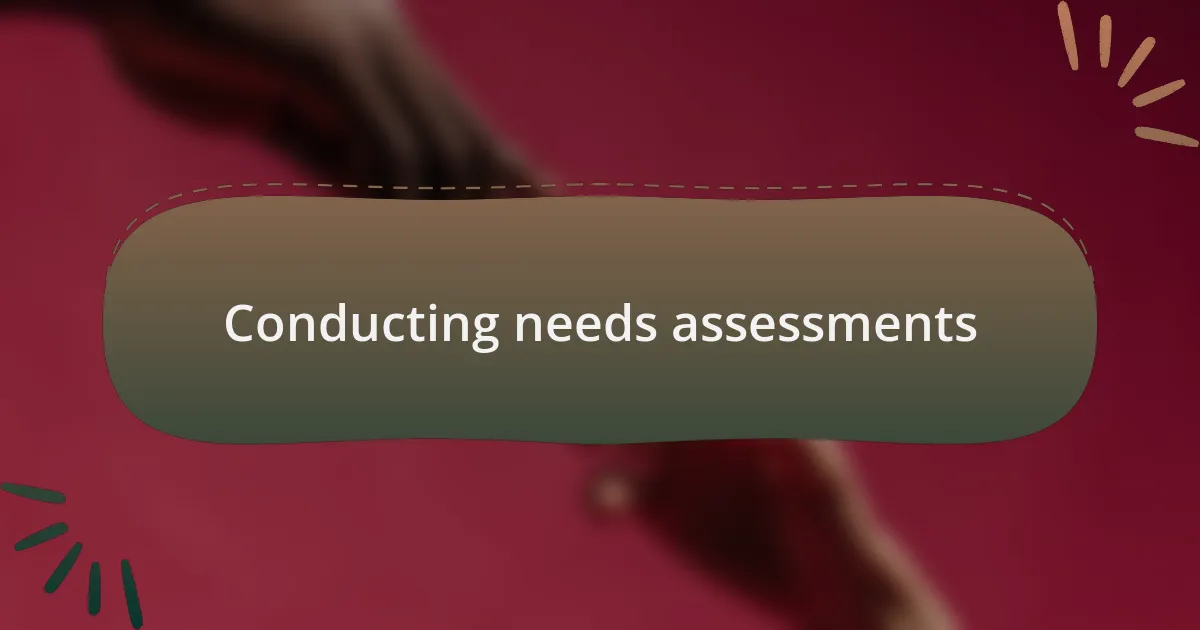
Conducting needs assessments
Conducting needs assessments is an essential step in crafting a gender-sensitive program. I vividly remember the day I gathered a diverse group for a community survey. It was eye-opening to hear people articulate their experiences, which ranged from workplace inequality to access to education. Listening to these stories made me realize how vital it is to tailor programs that genuinely reflect the needs of the community.
In my experience, using multiple methods for needs assessments can yield more comprehensive insights. For example, I once combined surveys with one-on-one interviews, allowing me to capture quantitative data alongside rich, qualitative narratives. This dual approach not only highlighted specific challenges but also revealed deeper social dynamics at play. Have you ever thought about how different perspectives can shed light on issues we often overlook?
Moreover, I learned the importance of creating a safe space during these assessments. The first time I met with a group of women hesitant to share their thoughts, I focused on building rapport and trust. Once they felt comfortable, their voices filled the room with powerful messages about their struggles and aspirations. It reinforced my belief that the assessment process is not just about gathering data; it’s an opportunity for empowerment and engagement. How can we ensure that every voice is not just heard, but valued?
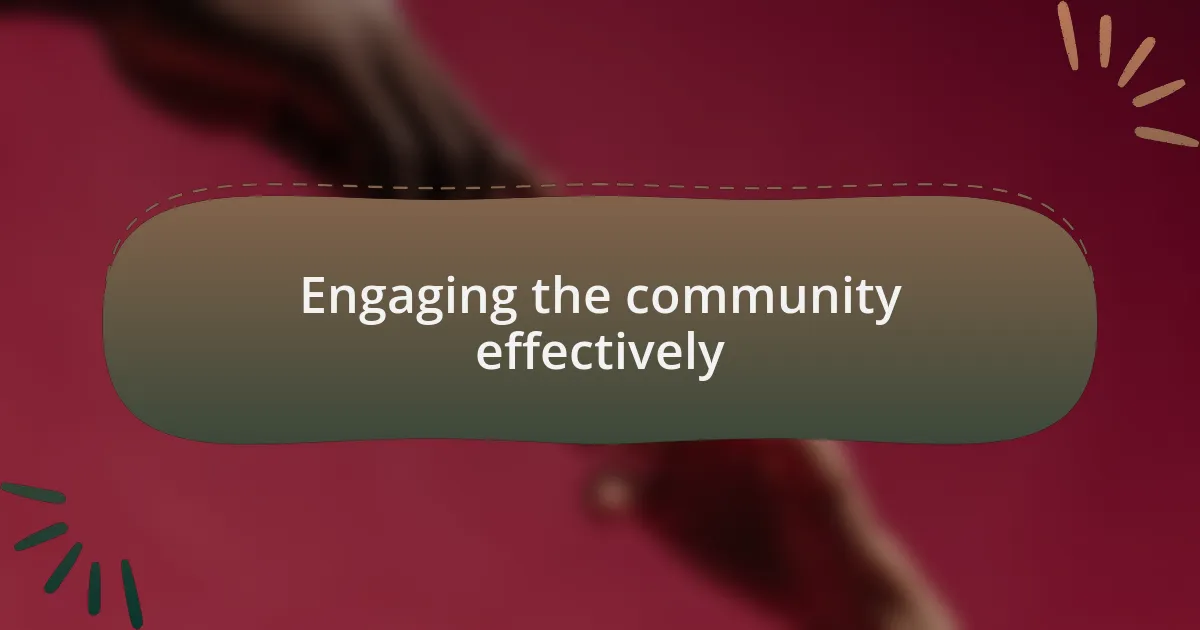
Engaging the community effectively
Engaging the community effectively requires intentionality and a genuine connection. I recall organizing a community forum where local leaders and residents came together to discuss pressing gender issues. The energy in the room was palpable; people were eager to share, listen, and suggest solutions. When I facilitated discussions, I was amazed by how much wisdom emerged when individuals felt valued and supported. Have you noticed how a safe, inviting space can transform a conversation?
I found that tailoring communication styles to fit the audience is crucial in fostering engagement. While working with different demographic groups, I blended storytelling with data to convey messages effectively. For instance, I used relatable metaphors that resonated with younger audiences while providing statistics that appealed to policymakers. This approach not only captivated attention but also created a bridge between complex issues and personal understanding. How do we ensure that our message resonates across diverse contexts?
Finally, ongoing collaboration with the community is vital for sustained engagement. I remember when a local women’s group invited me to co-create workshops that addressed specific needs they identified during previous interactions. Seeing their enthusiasm and ownership over the program was incredibly rewarding. It reinforced my belief in the importance of not just initiating conversations but keeping them alive. What steps can we take to maintain that momentum and continue empowering the voices around us?
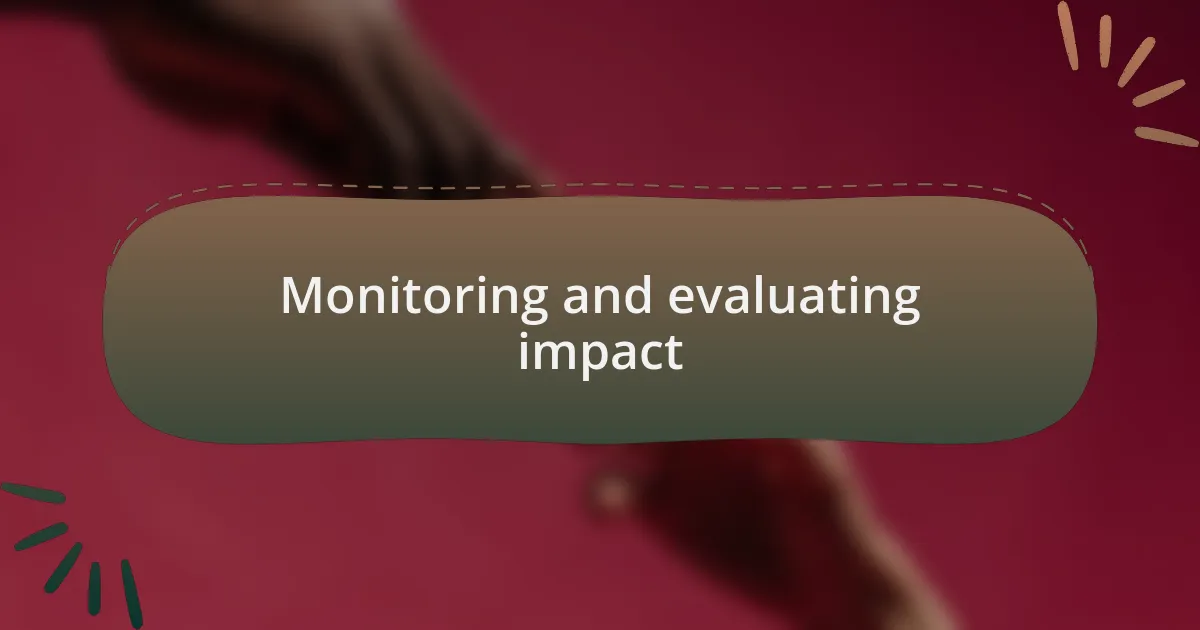
Monitoring and evaluating impact
Monitoring and evaluating the impact of our gender-sensitive program has been a revealing journey. I remember the exhilaration I felt when we gathered feedback from participants after our workshops. The stories they shared about personal growth and newfound perspectives provided concrete evidence that we were making a difference. It was a reminder that behind every statistic lies a real individual whose life is changing for the better. Have you ever felt that rush of validation when your work resonates so deeply?
Through consistent data collection methods, we were able to track changes over time. For instance, employing pre- and post-surveys helped illustrate the growth of understanding about gender equality among participants. There were moments when I was taken aback by the transformation in attitudes; seeing individuals who once held restrictive beliefs now advocating for equity was profoundly impactful. Did you know that tracking this evolution provides not just insights for our program, but also inspiration for others working in this space?
Additionally, I find that facilitating open discussions about evaluation with community members can enhance our monitoring efforts. During one session, a participant candidly expressed how certain aspects of the program could be improved, which sparked a rich dialogue. It was illuminating to witness their investment in the program’s success. This kind of collaborative evaluation fosters accountability and ensures the program continually aligns with the community’s evolving needs. How can we harness this feedback loop to not only measure impact but to refine our initiatives continuously?

Lessons learned from my experience
One key lesson from my experience is the power of adaptability. I remember a particularly challenging workshop where the materials we prepared seemed to miss the mark with participants. After careful reflection, I realized the importance of being flexible. We adjusted our approach on the spot, inviting participants to share their viewpoints, which turned a near disaster into an engaging discussion. Have you ever had that moment when pivoting from your original plan opens up a whole new level of understanding?
Another important takeaway is the value of authenticity in dialogue. I’ve found that when I share my own struggles with gender biases, it fosters a safe space for others to open up. During one discussion, a participant broke down while sharing her experience with discrimination. That moment reminded me that vulnerability can spark powerful connections. How often do we underestimate the impact of our own stories in creating a supportive environment?
Lastly, I learned that patience is vital in this work. Change doesn’t happen overnight, and sometimes it’s easy to lose sight of progress. I’ll never forget when a participant, who had initially been skeptical, later approached me to express how our sessions had influenced her perspective over time. It was a poignant reminder that genuine transformation is a gradual process. How do we cultivate that patience while constantly pushing for immediate results?